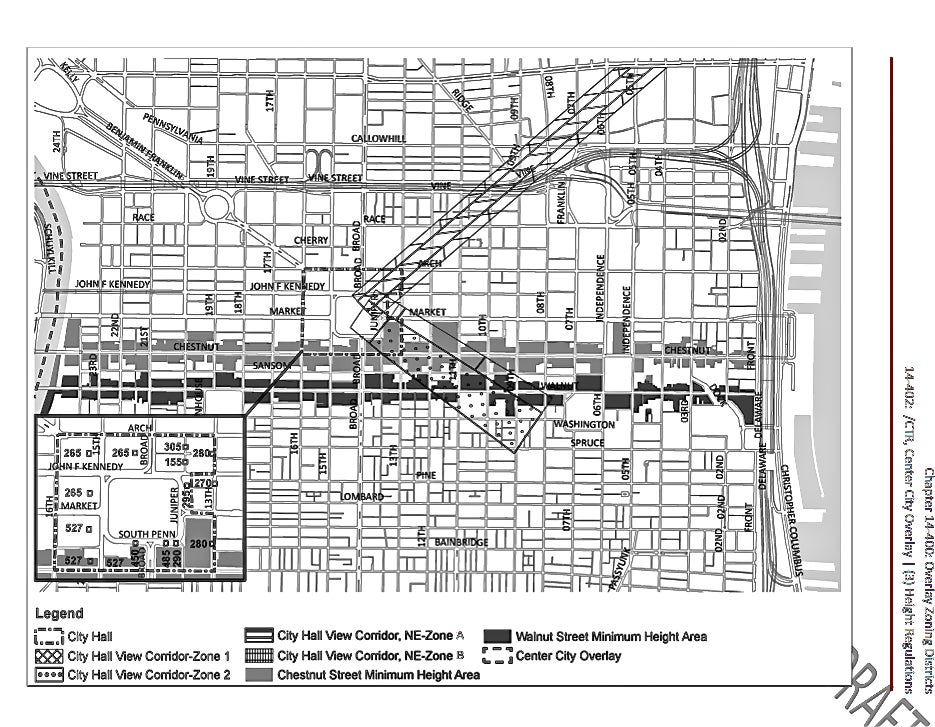Cutting through the Zoning Code: “Overlay Zoning Districts”

Overlay and special control districts are a few of the reasons that some argue the current Philadelphia Zoning Code is, well, bloated. By my reading of the current code, about 48 different provisions go above and beyond the basic zoning classifications. Think you’re in a basic C-2 Commercial District? You better check that you’re not also covered by one of the four dozen provisions, largely located in the “Miscellaneous” section of the current code, that might create a more restrictive environment for you.
Some provisions govern only a few blocks, such as the “North Central Front Street Special District Controls,” which, since August 2009, prohibits new performance venues, retail beer sales, takeout restaurants, and bath houses (among other uses) on the four blocks of Front Street between Girard and Oxford. Others govern only a relative handful of residences, such as the “River Road District Controls” section, which addresses the sewer needs of 40 homes on River Road in Northwest Philadelphia.
But all of them required legislative action by City Council. By my count, 206—that’s right, 206—legislative actions by City Council. Some provisions were passed as part of the same bills, but that’s a lot of time and attention paid to zoning. Nonetheless, this is indeed a responsibility of Council. Even though writing a new code can be seen as akin to pressing the zoning reset button, Philadelphia will surely see new amendments and ordinances as the city changes.
In the meantime, Chapter 14-400 of the new code, a/k/a “Overlay Zoning Districts,” takes—an axe? a torch?—something destructive, anyway, to the stack of special zoning controls. That’s not to say the controls have disappeared entirely. Rather, many of them are folded into the new overlays. The new Center City Overlay consumes just under half of this section, and incorporates many of the extant ordinances.
To address height and bulk concerns on Walnut and Chestnut Streets in Center City, this section also introduces the new sky plane controls that Zoning Code Commission member Peter Kelsen and consultant Don Elliott discussed at the October 6 ZCC meeting. More details will be in the forthcoming Zoning Code Administrative Manual, but the idea is that by addressing the bulk of the building—that is, how much of the sky and daylight it obscures—rather than the height and setbacks alone, more innovative designs will be permitted.
Check out the video
Reflecting how redevelopment has marched northwards, the Center City Overlay now extends all the way to Girard Avenue, and has a few other tricks up its sleeve. Want to open a new bar or restaurant in Old City that’s not on Market Street? Too bad for you: that use is prohibited, from Walnut to Spring Garden, and from Delaware Avenue to 5th or 7th Street, depending on how far north you are. And any new building and every change to an old one, between Race and Spring Garden and from river to river, must go before the Art Commission for approval.
By introducing a new Commercial Mixed-use District, CMX-2.5, the revised code eliminates many special control districts in the city’s residential neighborhoods. In theory, CMX-2.5 accommodates provisions that already established common commercial use regulations for neighborhoods, and appropriate lots will be remapped as CMX-2.5. The only commercial overlays included in the new code are for areas that have unique restrictions outside of what CMX-2.5 accommodates, including East Falls, Germantown Avenue in Chestnut Hill, Main Street and Venice Island in Manyunk, Passyunk Avenue, and Overbrook Farms.
Also staying: Queen Village’s neighborhood conservation overlay, and the area east of Broad Street and immediately south of Temple University keeps its restrictions on multi-unit and rental housing. The Delaware River Conservation District, barely a year old and designed to encourage parks and trails along the river in the Northeast. Another baby overlay approved by City Council in December, the City Avenue Overlay District, also is included, with extensive and specific design standards. And the Wissahickon Watershed Overlay District continues on, because nobody likes it when the Wissahickon floods.
Finally, the last three parts of this section are dedicated to building and noise regulations related to Philadelphia International Airport and Northeast Airport. Two of those three parts are reserved for overlays that are still up for discussion, but will address keeping buildings out of the paths of airplanes, and keeping airplane noise under 65 decibels for nearby residents.
Next episode: Tattoo parlors! Bars! Tobacco! Cell phone towers! Urban farms! Who gets them? Find out when use regulations rear their heads!
Also, Eva Gladstein, the chair of the ZCC, reminds me that if you’re unable to make an open house, the ZCC has a “Virtual Open House” (http://www.zoningcodeopenhouse.com/) that will walk you through zoning issues and changes to the code. It helps guide you to what’s of particular interest to you, so you can avoid doing what I’m doing in this column. The Virtual Open House lets you provide feedback to the ZCC too. Don’t forget that the deadline for written feedback is now November 12, but that’s less than three weeks away.
Contact the reporter at ngilewicz@planphilly.com
WHYY is your source for fact-based, in-depth journalism and information. As a nonprofit organization, we rely on financial support from readers like you. Please give today.



